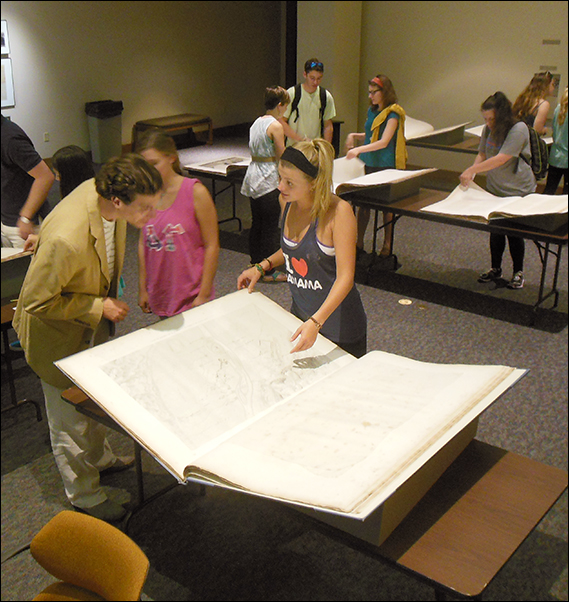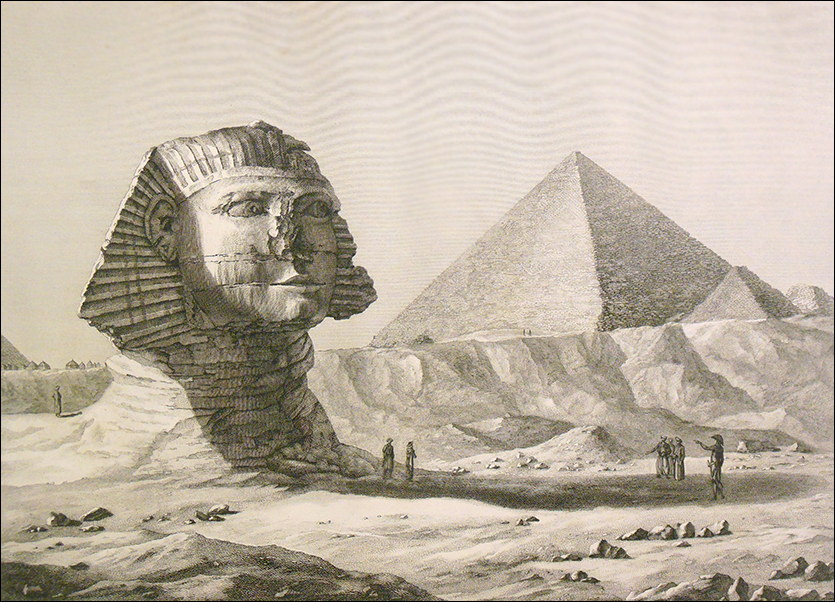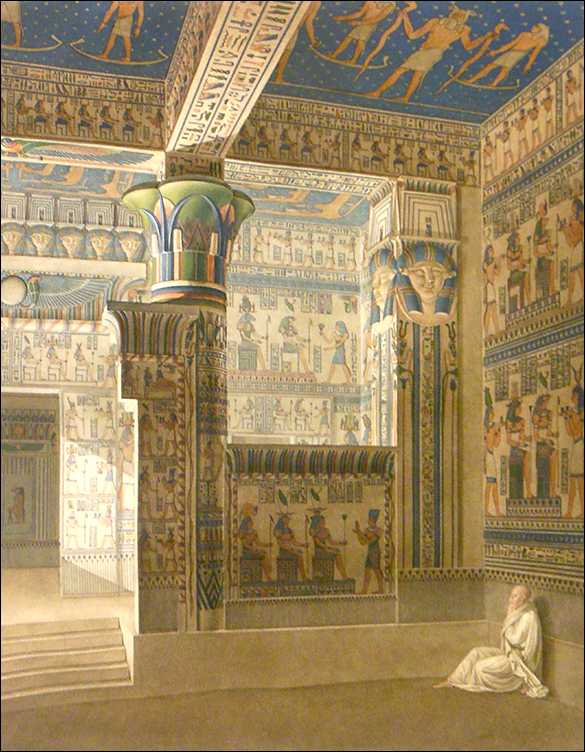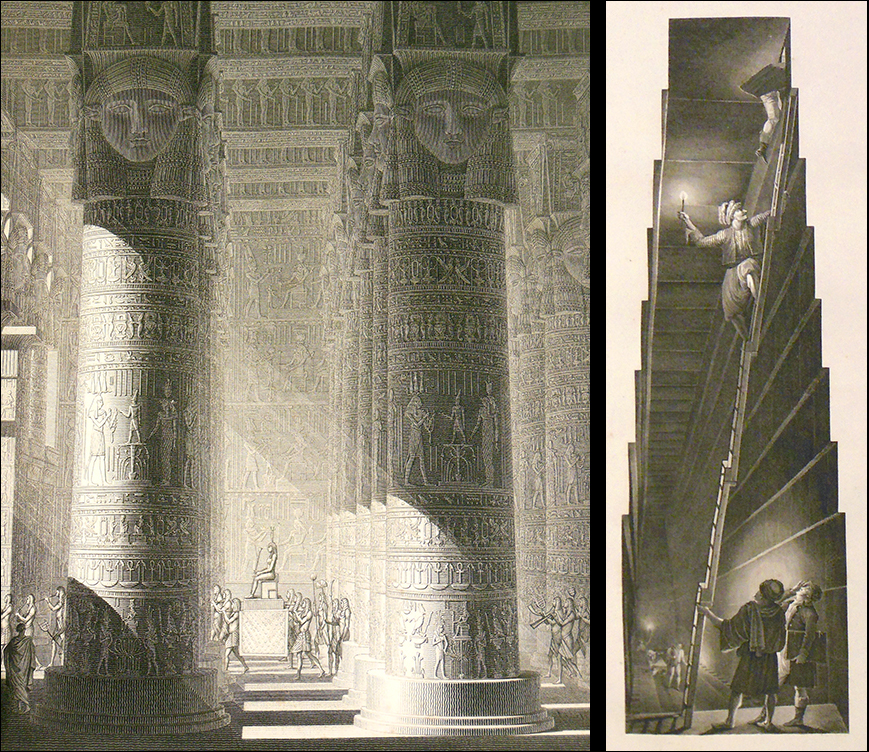Egyptomania!

Did you know you can travel from the delta of the Mississippi to the delta of the Nile... just by walking through the doors of Hill Memorial Library? That's what students in Professor Darius Spieth's History of Interior Design class did on September 9, when they came to Special Collections to view the Description de l'Égypte. Published in the wake of Napoleon's invasion of Egypt in 1798, this huge, multi-volume collection of engravings is one of the largest and most impressive books ever produced. Part science, part history, part propaganda, it helped trigger a craze in Europe and America for all things Egyptian—a craze known as Egyptomania. The book was especially influential in the fields of architecture and interior design. In 1798, the French government, under Napoleon Bonaparte, saw an opportunity to take control of Egypt. Napoleon realized that conquering the land of the pharaohs would provide France with a valuable colony, block a potential route to India for the British, and, best of all, add to his personal glory. But he also saw it as an opportunity for scientific and historical discovery. Although the French military campaign in Egypt ended in disaster a little over a year after it started, the small group of 151 scientists and artists that accompanied Napoleon’s army enjoyed more success, if no less hardship. Nicknamed the corps de savants, they had been enlisted to explore all they could about Egypt, which despite its proximity to Europe, was still a mystery. Their numbers included botanists, zoologists, chemists, physicians, engineers, antiquarians, and artists. Wherever the French army went, the “savants” followed, meticulously collecting data on everything from pyramids to palm trees.  Among the savants' accomplishments was the discovery of a stunning carving in the temple of Dendera, showing the signs of the zodiac. They entered the pyramids, explored the mysteries of the Sphinx, unwrapped mummies, mapped temple complexes, and, most significantly of all, discovered the Rosetta Stone, which their countryman Jean-François Champollion later used to decipher Egyptian hieroglyphs. The scientific expedition lasted three years. Thirty-one of its members died in Egypt or shortly after their return to France. “Many of the rest,” one historian has written, “returned home morally, emotionally, or physically altered for life. The experiment was so affecting that until the last of them died in the 1860s, they referred to one another as ‘the Egyptians’ and met annually to reminisce about the sand-drifted statues, temples, and tombs they had measured, sketched, and sought to understand.”
Among the savants' accomplishments was the discovery of a stunning carving in the temple of Dendera, showing the signs of the zodiac. They entered the pyramids, explored the mysteries of the Sphinx, unwrapped mummies, mapped temple complexes, and, most significantly of all, discovered the Rosetta Stone, which their countryman Jean-François Champollion later used to decipher Egyptian hieroglyphs. The scientific expedition lasted three years. Thirty-one of its members died in Egypt or shortly after their return to France. “Many of the rest,” one historian has written, “returned home morally, emotionally, or physically altered for life. The experiment was so affecting that until the last of them died in the 1860s, they referred to one another as ‘the Egyptians’ and met annually to reminisce about the sand-drifted statues, temples, and tombs they had measured, sketched, and sought to understand.”  Between 1809 and 1828, the official record of the scientific expedition was published in twenty-three volumes of text and plates. Today, only about 50 copies of the set are held by American libraries. Special Collections owns the plate volumes, which the university is thought to have acquired early in its history. Although best known for their depiction of monuments, statues, and inscriptions from ancient Egypt, the volumes also cover natural history, geography, and life in Muslim Egypt at the turn of the nineteenth century, including architecture, interior design, dress, and customs. Numerous other rare books on Egypt are available in Special Collections. Highlights include Claude Etienne Savary's Lettres sur l’Égypte (1785), James Bruce's Travels to Discover the Source of the Nile (1790), and Narrative of the Operations and Recent Discoveries within the Pyramids, Temples, Tombs, and Excavations, in Egypt and Nubia (1822) by the pioneering archaeologist Giovanni Battista Belzoni. We also have several fragments of ancient Egyptian papyrus and even a collection of mummy wrappings with examples of ancient writing. To explore additional holdings, do a search in the catalog using the keyword "Egypt" and limit your search to the Rare Book Collection. If you need help searching, or have other questions, please feel free to visit the library or email us at special@lsu.edu.
Between 1809 and 1828, the official record of the scientific expedition was published in twenty-three volumes of text and plates. Today, only about 50 copies of the set are held by American libraries. Special Collections owns the plate volumes, which the university is thought to have acquired early in its history. Although best known for their depiction of monuments, statues, and inscriptions from ancient Egypt, the volumes also cover natural history, geography, and life in Muslim Egypt at the turn of the nineteenth century, including architecture, interior design, dress, and customs. Numerous other rare books on Egypt are available in Special Collections. Highlights include Claude Etienne Savary's Lettres sur l’Égypte (1785), James Bruce's Travels to Discover the Source of the Nile (1790), and Narrative of the Operations and Recent Discoveries within the Pyramids, Temples, Tombs, and Excavations, in Egypt and Nubia (1822) by the pioneering archaeologist Giovanni Battista Belzoni. We also have several fragments of ancient Egyptian papyrus and even a collection of mummy wrappings with examples of ancient writing. To explore additional holdings, do a search in the catalog using the keyword "Egypt" and limit your search to the Rare Book Collection. If you need help searching, or have other questions, please feel free to visit the library or email us at special@lsu.edu. 
